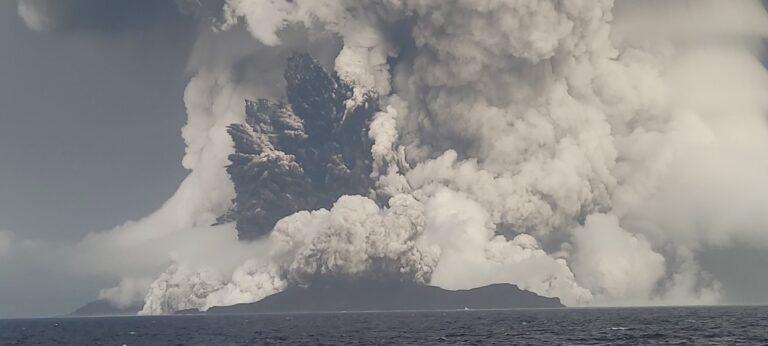© 2011-2025 The Avataric Samrajya of Adidam Pty Ltd, as trustee for the Avataric Samrajya of Adidam. All rights reserved.
Posted January 2022

On Saturday, 15 January 2022 at about 4:15 PM Fiji time a very strong volcanic eruption occurred on Hunga Tonga in the Kingdom of Tonga. According to NASA scientists its explosive force was hundreds of times more powerful than the atomic bomb the US dropped on Hiroshima during World War Two.
Before the eruption, the Hunga Tonga–Hunga Ha’apai volcanic island was two separate islands joined by new land formed in 2015. The eruption was so powerful all the new land has gone, along with “large chunks” of the two older islands.
Tonga is located about 580 km (360 miles) southeast of Naitauba. At around 4:40 PM Fiji time, Naitauba residents began hearing noises that sounded like strong thunder from a nearby storm. However, neither we nor the meteorologists at the Fiji Meteorological Service could locate any nearby thunderstorm clouds or explain the noise.
At around 4:45 PM all of Naitauba was shaken by a strong percussive shockwave that sounded like nearby artillery fire. More, but less powerful, percussive waves continued for over an hour. About 30 minutes into the acoustic mystery, we guessed that perhaps a Tongan volcano was exploding and we began searching online for reports of tsunami waves heading our way. We found reports of small waves coming ashore in the Southern Lau island group, and around 5:30 PM we noticed very disturbed and disorganized seas all around Naitauba, but there was no tsunami. Thankfully, due to favorable winds and the orientation of the blast, Naitauba and all of Fiji also escaped damage from ash and acid rain generated by the volcano.
The volcanic eruption was the largest recorded in thirty years, producing a huge, 20 km-high mushroom-shaped cloud of ash and smoke. The Tongan archipelago was largely cut off from the outside world for five days because the explosions severed the sole fiber-optic undersea cable bringing internet to the island. The government of Tonga and humanitarian partners have since reported that the entire population of Tonga (approx. 105,000 people) was impacted, and that about 83% of the population was directly affected. Initial assessments indicated that about 240 houses were damaged or destroyed.
Researchers have found geologic evidence of two huge eruptions from the Hunga caldera in deposits on the old islands. The evidence was matched chemically to volcanic ash deposits on the largest inhabited island of Tongatapu, 65km away, and radiocarbon dating was used to show that big caldera eruptions occur about every 1000 years, with the last one at 1100 AD. Therefore, the massive eruption on January 15 seems to be right on schedule.
It remains unclear if this is the climax of the eruption. The 15 January event represents a major magma pressure release, which may settle the system. A warning, however, lies in geological deposits from the volcano’s previous eruptions. These complex sequences show each of the 1000-year major caldera eruption episodes involved many separate explosion events. Hence Tonga could be in for several weeks or even years of major volcanic unrest from the Hunga Tonga–Hunga Ha’apai volcano.
© 2011-2025 The Avataric Samrajya of Adidam Pty Ltd, as trustee for the Avataric Samrajya of Adidam. All rights reserved.